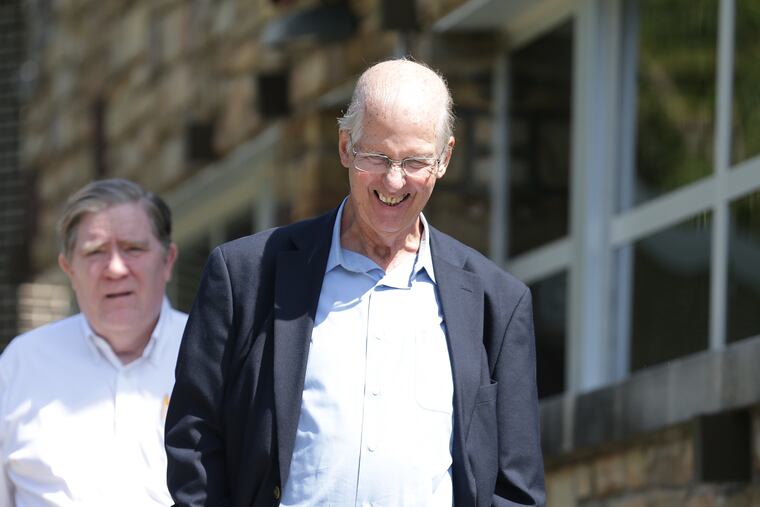These alleged abuser priests were scot-free for decades — until they weren’t | Maria Panaritis
Francis Trauger and Robert Brennan. Their arrests this past week were surreal.

The creepy smile.
In photos of defrocked archdiocesan priest Francis Trauger last week outside a Bucks County police station, the alleged child sexual predator flashed an outsized grin. He was wearing a suit jacket that flitted as he moved an arm. The pose was more fashion-catalog preen than street candid of a 74-year-old being booked for molesting children.
Then again, Trauger had evaded justice since at least 1981. So that megawatt grin? Maybe it was just that of a septuagenarian who knew that he’d mostly dodged the system.
His arrest after so many decades was itself as startling as the images shot by an Inquirer photographer. But there soon was more to fuel a sense of unease.
Two days after Trauger’s arrest on assault charges out of Bristol, another disgraced priest’s face was blasted into the news, that of defrocked Archdiocese of Philadelphia cleric Robert L. Brennan. The feds snapped up the octogenarian in Maryland on charges that he lied to the FBI in Philadelphia about his relationship with the family of a young victim, Sean McIlmail. Sean died the last time Brennan faced charges. His death had made the case fall apart a few years ago.
No victim, no crime.
Trauger. Brennan. Names and faces I had never forgotten.
I’d spent many months 17 years ago trying to chase allegations that these then-active priests were abusers. Their arrests by state and federal prosecutors now, nearly two decades later, are a testament to the perseverance of prosecutors and victims. Even against long odds and a statute of limitations too short to allow most prosecutions, they have refused to dim the spotlight on these horrors that the church helped go undetected and, as a tragic result, unprosecuted.
“Somebody like Francis Trauger violated the ultimate trust," Bucks County District Attorney Matt Weintraub told me Friday in an interview about the case built on allegations by two victims. "He abused his position in the church as a man of God to entrap these poor boys. If there are others out there like them, I want to know about it and, if we can, we will prosecute them and others.”
Trauger and Brennan are among scores of Catholic clergy in Pennsylvania who skirted criminal charges for what one grand jury after another has outlined, in reports released since 2005: decades of abuse against children.
The abuse was often concealed from parishioners and law enforcement by bishops and their underlings.
Trauger’s case grew from victim accounts in the wake of Pennsylvania’s state grand jury report released by the Attorney General’s Office last year. Brennan’s is the first from a grand jury probe launched late last year by the U.S. Attorney’s Office in Philadelphia.
Trauger, 74, was charged on Tuesday, Brennan, 81, on Thursday.
Both men had been an intensive, if impermanent, part of my journalistic life two decades ago.
In 2002, the national clergy abuse scandal was exploding into view. Serial abusers had gotten away with raping children in the Archdiocese of Boston. Priests were moved from parish to parish while religious bigwigs kept the faithful in the dark about the dirt that had been flowing into chancery offices about the clerics’ criminality.
What was unknown at the time was just how much the Archdiocese of Philadelphia had done the same in Philadelphia and its four surrounding counties. The Inquirer put together a five-member team to investigate as the names of suspected abuser priests flowed into the newsroom.
My priests: Trauger and Brennan.
Their parish assignments alone had raised alarms. They’d been moved around a lot, as the Catholic Directories we’d stockpiled going back decades showed. Then-Philadelphia District Attorney Lynne Abraham’s prosecutors would soon discover, by launching a three-year grand jury probe that would force documents out of diocesan files under subpoena, that this was no accident.
“Ordained in 1972,” the grand jury wrote in 2005, “Fr. Trauger was transferred eight times during his long career, each time to a parish with a school attached, each time without a warning to parish parents about the priest’s predilections. Six of the transfers occurred after 1981, when the Archdiocese began recording abuse allegations.”
I recalled pursuing disturbing allegations about his time at Holy Cross in Springfield.
Brennan had been moved around so much, with so many questions about his whereabouts, that I had to build giant posters laying it out in large type. He’d allegedly gotten into trouble at St. Ignatius in Yardley, then at St. Mary’s in Schwenksville, and was, at the time of our reporting efforts, serving at Resurrection of Our Lord in Northeast Philadelphia.
When I tracked Brennan down at Resurrection after Mass one day, I asked him about some of the allegations that had been brought to my attention. There was a look of shock on his face.
Sadly, I remember little more. Those notes are now gone.
We owe prosecutors a huge debt in this state for keeping the pressure on and creating what Weintraub calls powerful “momentum.” It is not easy to keep pounding away at corruption and criminality when the statute of limitations is so narrow that few cases can be brought.
“My hope is to perpetuate it," Weintraub said, "by announcing these arrests and seeking more victims.”
Let’s hope that U.S. Attorney William McSwain is only just beginning, too.